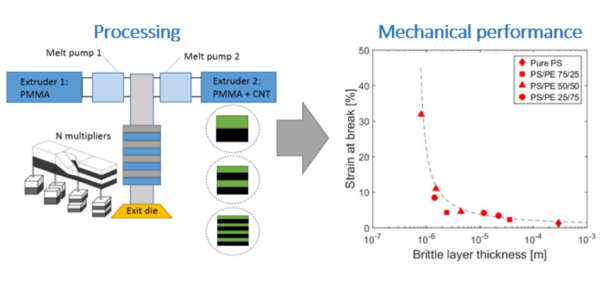
Polymer composites are often used due to the possibility to combine two or more materials into one structure with enhanced properties. An approach to combine two individual polymers is coextrusion, which stacks the multiple polymers in a layered structure. In the 1960s, a layer multiplying die element was developed, which allowed production of multilayered films composed of hundreds or thousands of layers, which can show unique properties.
The multilayered films created in this project contain alternating layers of pure PMMA and PMMA with 3 wt. % of multi-walled carbon nanotubes (3CNT). After proper production, without any distortions and straight interfaces between the layers, the main goal of the project is to monitor, investigate and optimize the mechanical behavior of the PMMA-3CNT films. In this mechanical analysis the goal is to see the effect of the layer thickness and the number of layers on the mechanical properties of the final produced films.
There are two possible ways to increase the strength of the multilayered films: reaching a critical thickness or damage delocalization. According theory, there will be a brittle to ductile transition by reducing the layer thickness to tens of nanometers. Even when this thickness cannot be achieved, the strength properties can be increased by delocalization of damage. Delocalization of damage is a result of bifurcation of cracks into multiple cracks which, consequently, increase the fracture surface.
Contact
-
Zara Kurt MAElize Ramakervan der Maathlaan1689BJ Warfhuizen
-
ds. Danique Groen BscEvelien Aslan BAKorkmazstraat3274LD Oudemirdum
-
ing. Muhammed Simsek BASienna de Bruijn BAJorissenlaan5223BK Lettelbert
-
Jamie KuipersIse Uysalvan Luindreef4703LB Rozenburg